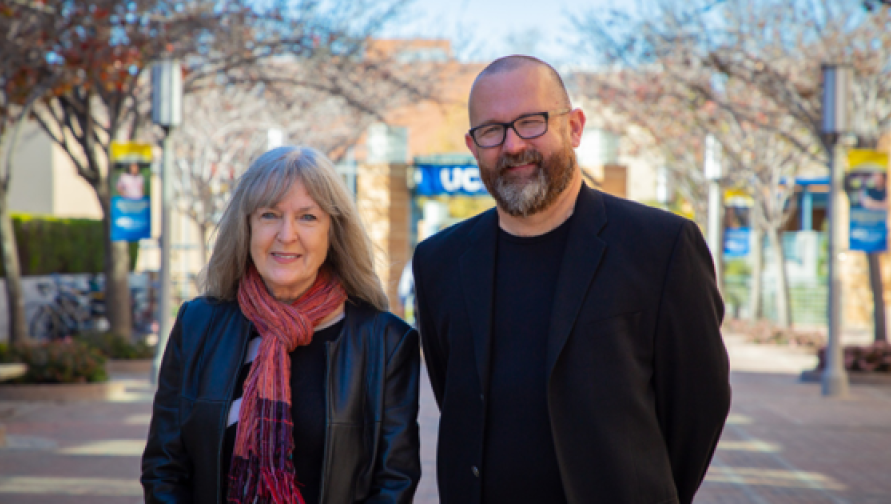
By Lori Basheda
Can the language of civil disruption and protest be learned? Should it be taught in an academic setting?
It was the high-profile "Irvine 11" protest at the University of California, Irvine in 2010 that inspired professors Jonathan Alexander and Susan C. Jarratt to team up to consider these questions.
Ten Muslim students, from UC Irvine and UC Riverside, made national headlines when an Orange County jury found them guilty of conspiring to disrupt – and then disrupting – a speech on campus by the Israeli ambassador to the U.S. The ten were sentenced to community service and three years informal probation (an 11th defendant—hence, “Irvine 11”—was dismissed before the trial).
At the time, Jarratt was a professor of comparative literature (she retired in 2016). She had also served as campus writing coordinator from 2001 to 2007 until turning the reins over to Alexander, who stepped down from that position in December. He’s currently a Chancellor’s Professor of English and informatics.
Together, they penned an article on the rhetorical strategies used by the Irvine 11, titled “Rhetorical Education and Student Activism,” for a 2014 issue of College English.
Alexander and Jarratt interviewed five of the protestors about the ways in which they prepared strategically to interrupt the ambassador’s speech. They wanted to know how the students’ upbringings, experiences, and self-education influenced their motivation to act and their decision on how to protest.
What they found was that the students were influenced largely by their own “genealogies of activism”—that is, activism they learned culturally, through self-education and personal experience, rather than in a formal academic setting. Alexander and Jarratt concluded their article by saying, “Future studies of rhetorical education should encompass the curricular and the co-curricular, the formally sponsored and the self-sponsored, as mutually informing resources if research in rhetoric and writing studies is to contribute vitally to a collective struggle for cultural understanding and peaceful coexistence.”
Their work on the article then led them to tackle another question inspired by the same incident. Specifically, what place does unruliness have in civic life and in the university setting?
“A lot of writing classes prepare students for the kinds of writing they’re going to do for other classes; analysis, critical thinking,” Alexander says. “A different kind of writing course might organize around how to prepare students for writing outside of academia—for the kinds of writing that students might find enriching or useful in their civic lives.”
“In what moments has a group or an individual acted in an unruly manner as a form of protest in order to be heard or to express outrage at an injustice,” Jarratt asks. “And should those rhetorics be taught, too?”
This time, Jarratt and Alexander invited colleagues across the country to weigh in. Teaming up with University of Vermont professor Nancy Welch, who specializes in rhetoric, the trio collected 15 essays for a book titled Unruly Rhetorics: Protest, Persuasion and Publics, published this past November.
“Can the practice of unruliness be learned and repeated?” they ask in the introduction. “Should unruly rhetorics be taught?” Or would “any attempt to formalize or regularize the unruly do an injustice to the spontaneity, creativity … of such outbreaks. Indeed, the idea of teaching unruliness seems like the opposite of the unruly.”
The Irvine 11 incident, however, wasn’t spontaneous. It was staged, and if you consider the national attention it got, it was effective despite the local consequences.
When members of the Muslim Student Union shouted out slogans during the ambassador’s speech, what appeared to be spontaneous was actually the result of thoughtful deliberation, Alexander and Jarratt write.
The book points out that many “writing and rhetoric teachers are committed to activism and have devised creative ways of incorporating activist elements into their curricula.”
Rhetorical preparation for such unruliness, then, “can be fostered within as well as outside the curriculum.” Many political actors have learned from each other even if not in a formal instructional setting; Martin Luther King Jr.’s adoption of Gandhi’s practice of non-violence serves as one famous example.
In each of the 15 chapters in Unruly Rhetorics, scholars analyze specific cases of unruliness “in public scenes ranging from street demonstrations to encounters in state houses and on university campuses, staging performances and occupations.”
In the essay “A Groove We Can Move To,” scholar and McGill University professor Jonathan Sterne writes about Montreal University students carrying out pot-banging protests in 2012, successfully staving off tuition hikes.
“Student unions turned to social media to publicize key days of action, but it was the sea of red-shirted college students filling the boulevards. … in traditional pot-banging protest that repeatedly transformed the city of Montreal into a public space for broadcasting the students’ demands,” he wrote.
In another chapter, titled “Walking with Relatives: Indigenous Bodies of Protest,” Joyce Rain Anderson focuses on the U.S. and Canadian movements against the Keystone XL and Dakota pipelines. A hunger strike, flash mob style dancing, and occupations brought “native bodies into public focus.”
Jarratt’s specialty is ancient Greek rhetoric, and she points out that ancient orators explored the complexities and power of public speech.
“Contemporary media have made big changes,” she says. “But there are still similarities about standing up in front of people to make a case; there are risks to being a free speaker.”
Jarratt and Alexander hope to continue exploring how people stand up to speak, even and perhaps especially under conditions of risk, and how educators might prepare students to engage in such important rhetorical — and political — activity.

